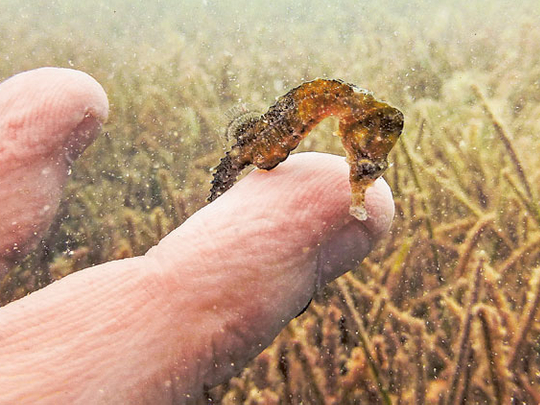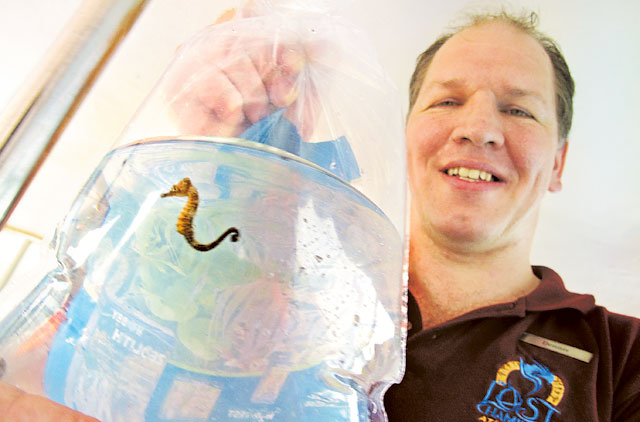
Dubai: Marine scientists at Atlantis, The Palm, took the first steps on Thursday toward creating a new colony of seahorses to help rejuvenate diminishing native herds of the tiny creatures in UAE waters.
Looking much like the proud father, Dennis Blom, manager of the Lost Chambers at Atlantis, plunged into the clear blue waters off Port Jebel Ali with two plastic bags filled with 50 rare newborn seahorses he gingerly raised in nursery tanks at the hotel marine sanctuary.
On a glassy sea in late morning, Blom then swam to the seabottom three metres below and delicately released his tiny charges, whose scientific name is Hippocampus Hystrix, into thick croppings of dark green seagrass flourishing in the protected waters of a nearby deserted beach.
“As soon as they were in the seagrass, they disappeared,” said Blom after resurfacing near a support vessel loaned to the project by Emirates Marine Environmental Group (EMEG).
The disappearing trick is an innate survival skill in which seahorses’ outer appearance can be changed to emulate the colours and patterns of their environment to give the marine animals superb camouflage.
At a length of roughly four centimetres, the newborn seahorse fry need every evolutionary advantage against larger predators that they can muster in order to survive to adulthood where they can reach 10cm in length and live for up to three years in the wild.
The seahorse release project is important, Blom said.
“Seahorses are native to UAE waters and they are protected in their home waters,” he said. “With projects such as this, hopefully we can increase their numbers. Before, there used to be a lot of them.”
The release site is an ideal setting for the seahorse colony project because the seafloor has large swathes of natural seagrass, a natural home in which the seahorses can hide. Strong tidal flows in the area will ensure that there is lots of natural live food for the seahorses to establish a sustainable colony, Blom said.
“There is a lot of food around here, the low tide brings in a lot of food and it will help them in the long run,” he said. “We are trying to bring back a whole colony here to re-seed other new colonies.”
The project has received the full backing of Trakhees -- Environment, Health and Safety (EHS).
Marine colleagues at Atlantis, The Palm, are rooting for the new seahorse conservation project.
Steve Kaiser, vice-president of Marine Sciences and Engineering at Atlantis, said any project aimed at repopulating depleted marine stocks raises the hopes of everyone.
“The birth of any threatened species helps us further our goal of educating and enlightening people about marine life and ecosystems,” said Kaiser.
“By releasing a number of these new seahorses into the Gulf, we hope to help bring their numbers back from the brink.”
Blom, meanwhile, said that the 50 seahorses released into the wild were only fed live food since hatching to help boost their introduction into the wild where they will continue to eat zooplankton in the lazy ebb and flow of Gulf underwater currents.
As part of this year’s successful breeding program of the species at Atlantis aquariums, about one third were released into the wild while a further 100 seahorses born and bred at Atlantis are being raised in a small protected aquarium designed to help raise public awareness about the endangered species.
Inside the The Lost Chambers Aquarium, two species of seahorses, the Hippocampus Hystrix and Hippocampus Reidii, are on display for curious public visitors.
Atlantis marine scientists encourage visitors to help endangered seahorses, not hinder them by purchasing dried seahorse products used for medicine or for decoration.













